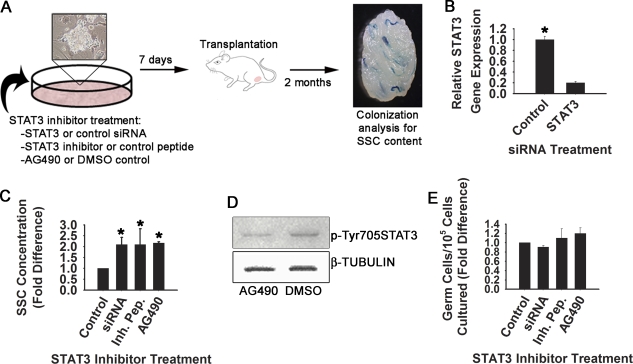FIG. 3.
Effects of impaired STAT3 function on SSC activity in cultured THY1+ germ cell populations. A) Experimental strategy for examining the role of STAT3 in SSC functions in vitro. Cultured THY1+ germ cells were treated with Stat3 siRNA, a cell-permeable STAT3 inhibitor peptide, or the pharmacological inhibitor of STAT3, AG490. Controls were cells treated with nontargeting siRNA, an inactive peptide, or DMSO. After 7 days, which is slightly greater than one SSC self-renewal cycle of 5.6 days in cultured THY1+ germ cell cultures, SSC content of experimental cell populations was determined by transplantation into recipient mouse testes that were then examined for colonization 2 mo later. Quantification of colony number is a direct measure of SSC content in a microinjected cell suspension. B) Quantitative RT-PCR analyses of relative Stat3 gene expression 24 hours after treatment with Stat3 or control siRNA. Stat3 treatment resulted in 80.2 ± 2.6% (n = 3 different primary cultures) reduction of Stat3 expression compared with control siRNA treatment. C) Quantification of SSC concentration in cultures of THY1+ germ cells treated with different STAT3 inhibitors or control treatments after one self-renewal cycle. SSC numbers are derived from transplantation analyses, and are expressed as fold difference compared to control. SSC content was 2.1± 0.3-, 2.1 ± 0.7-, and 2.2 ± 0.1-fold greater for siRNA-, inhibitor peptide-, or AG490-treated cells compared with controls, respectively. Data are mean ± SEM for two independent experiments of different primary cultures of THY1+ germ cells and 16–20 transplanted recipient mouse testes. *Significantly different from control at P ≤ 0.05. SSC numbers for all controls are set at 1, and SSC numbers for treatments are presented as fold difference compared to the corresponding control. D) Representative images of Western blot analysis for phosphorylated STAT3 expression in cells treated with the pharmacological inhibitor AG490, or DMSO as the vehicle control. The top panel represents expression of STAT3 phosphorylated at tyrosine residue 705, and the bottom panel represents reprobing of the same blot for expression of the housekeeping gene Tubulin-beta. E) Quantification of total germ cell numbers in cultures of THY1+ germ cells treated with different STAT3 inhibitors or control treatments after one self-renewal cycle of 7 days. Data are mean ± SEM for two independent experiments of different primary cultures of THY1+ germ cells, and are derived from the same cell populations used for transplantation analyses. Germ cell numbers for all controls are set at 1, and germ cell numbers for treatments are presented as fold difference compared to the corresponding control.

